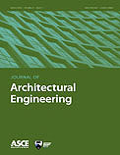
Journal of Architectural Engineering
Scope & Guideline
Elevating Standards in Architectural Engineering Research
Introduction
Aims and Scopes
- Sustainable Building Design and Construction:
The journal emphasizes research on sustainable practices in building design and construction, exploring methodologies that reduce environmental impact and enhance energy efficiency. This includes the use of renewable energy systems, sustainable materials, and eco-friendly construction techniques. - Building Performance Optimization:
A core focus is on optimizing building performance through advanced design techniques, including thermal, visual, and acoustic performance assessments. Studies often involve simulations and modeling to enhance comfort and energy efficiency in various climates. - Innovative Construction Techniques and Technologies:
The journal explores cutting-edge construction methods such as 3D printing, modular construction, and the application of Building Information Modeling (BIM) to streamline processes and improve project outcomes. - Health, Safety, and Indoor Environmental Quality:
Research related to indoor air quality, thermal comfort, and safety in building design is a significant area of interest, aiming to improve occupant well-being and resilience in built environments. - Integration of Digital Technologies in Architectural Engineering:
The use of digital tools, such as machine learning, virtual reality, and artificial intelligence, is a growing area of research, focusing on enhancing architectural education and professional practice. - Resilience and Adaptability in Architecture:
The journal promotes studies on designing buildings that can adapt to changing environmental conditions and societal needs, including research on disaster-resistant structures and retrofitting existing buildings.
Trending and Emerging
- Integration of Renewable Energy Systems:
There is a significant increase in research focusing on integrating renewable energy systems into building designs, reflecting a growing commitment to sustainability and energy efficiency in the built environment. - Digital Transformation in Architectural Engineering:
The application of digital technologies, such as BIM, AI, and machine learning, is trending as researchers explore their potential to enhance design processes, construction efficiency, and building management. - Resilient and Adaptive Design Strategies:
Emerging themes include the development of designs that can withstand natural disasters and climate change impacts, emphasizing resilience in architectural engineering. - Health and Well-Being in Building Design:
Research increasingly emphasizes the importance of indoor environmental quality, occupant health, and well-being, aligning with global trends towards healthier living and working environments. - Sustainable Materials and Waste Reduction:
There is a notable trend towards researching sustainable materials and methods to reduce construction waste, highlighting the importance of circular economy principles in the building sector. - Smart Building Technologies:
The rise of smart building technologies, including automation and IoT integration, is becoming a focal point, as these innovations promise to enhance energy efficiency and occupant comfort.
Declining or Waning
- Traditional Construction Methods:
Research focusing on conventional construction techniques has seen a decline as the field increasingly shifts towards innovative and sustainable practices. The emphasis is now more on modern methodologies that incorporate technology and sustainability. - Historical Architectural Studies:
While historical architecture remains important, there appears to be a waning interest in studies that do not directly address contemporary engineering challenges or sustainability issues, reflecting a focus on current and future needs. - Static Design Approaches:
The focus on static analysis and design approaches is declining in favor of dynamic systems and adaptability, as architects and engineers increasingly recognize the need for structures that respond to environmental changes. - Basic Materials Research:
Basic research on conventional building materials is less frequent, as the journal emphasizes innovative materials and sustainable alternatives, reflecting a shift towards eco-friendly solutions.
Similar Journals
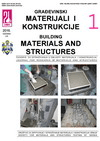
Gradevnski Materijiali I Konstrukcije-Building Materials and Structures
Exploring the intersection of materials and structural integrity.Gradevnski Materijiali I Konstrukcije - Building Materials and Structures is a premier open-access journal dedicated to advancing the field of construction materials and structural engineering. Published by SOC MATERIALS & STRUCTURES TESTING SERBIA, this journal provides a platform for researchers, professionals, and students to share their innovative findings and developments in building materials. With a commitment to open-access since 2012, it fosters unrestricted availability of research for a wider audience, encouraging collaboration and knowledge dissemination. The journal features a diverse range of topics, including material testing, structural integrity, and sustainable construction practices, making it a vital resource for those engaged in the design and analysis of structural components. By fostering the advancement of research and practice in this crucial sector, Gradevnski Materijiali I Konstrukcije plays an essential role in shaping the future of construction and material science.
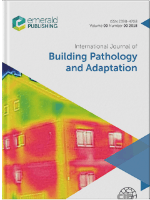
International Journal of Building Pathology and Adaptation
Advancing resilience in the built environment.International Journal of Building Pathology and Adaptation is a premier publication dedicated to advancing knowledge in the field of building pathology and adaptation. Established by the esteemed Emerald Group Publishing Ltd, this journal serves as a vital platform for researchers and practitioners focusing on the assessment, preservation, and innovative adaptation of built environments. With an impressive Q2 ranking in both Building and Construction and Civil and Structural Engineering, and a Scopus ranking of #62 out of 223 in the relevant engineering disciplines, the journal showcases high-quality research with significant practical implications. Although currently not featuring an open-access model, its access options cater to a wide audience aiming to explore cutting-edge studies from 2017 to 2024. The journal's commitment to bridging the gap between academic inquiry and real-world application makes it an essential resource for anyone dedicated to advancing the resilience and sustainability of the built environment.
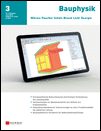
Bauphysik
Pioneering Insights in Building Physics and EngineeringBauphysik, published by ERNST & SOHN, is a prestigious journal dedicated to the fields of architecture, building construction, and environmental engineering. With a strong focus on the principles of building physics, Bauphysik serves as a key platform for researchers, professionals, and students alike, disseminating vital information and advancements within the industry. The journal, boasting an ISSN of 0171-5445 and an E-ISSN of 1437-0980, is well-regarded with a categorization in the Q2 quartile in Architecture and Q4 quartiles in Building and Construction and Environmental Engineering as of 2023. Its Scopus ranks further highlight its impact within the community, with rankings of 83/189 in Architecture, 179/223 in Building and Construction, and 167/197 in Environmental Engineering. Despite its lack of open access options, the journal's retrospective convergence from 1982 to 2024 marks its long-standing influence in advancing building physics research. With a dedicated readership, Bauphysik encourages the exploration and sharing of innovative solutions to contemporary challenges in the built environment.
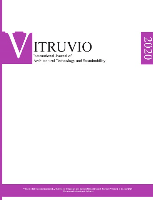
VITRUVIO-International Journal of Architectural Technology and Sustainability
Exploring innovative solutions in architectural technology.Welcome to the VITRUVIO-International Journal of Architectural Technology and Sustainability, a leading open-access journal published by UNIV POLITECNICA VALENCIA, EDITORIAL UPV since 2015 and based in Spain. With its ISSN 2444-9091, this journal is dedicated to advancing the field of architectural technology and sustainability, providing a vital platform for researchers, professionals, and students alike. The journal has made significant strides in the academic landscape, achieving a Q3 ranking in Architecture and a Q4 ranking in Building and Construction for 2023. It features a diverse range of scholarly articles that explore innovative practices, cutting-edge research, and sustainable solutions in architecture. With a Scopus ranking placing it at #70/189 in Architecture and #161/223 in Building and Construction, it is positioned within the 63rd percentile and 28th percentile respectively, demonstrating its increasing impact in these vital fields. We invite you to engage with our content and contribute to the ongoing discourse around sustainability in architectural practice.
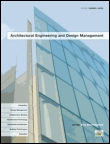
Architectural Engineering and Design Management
Advancing sustainable design and innovation in architecture.Architectural Engineering and Design Management, published by Taylor & Francis Ltd, is a leading journal dedicated to the interdisciplinary fields of architectural engineering and design management. Since its inception in 2005, the journal has established itself as an essential resource for researchers and practitioners, showcasing the latest developments and innovative practices within the architecture and construction industries. With a commendable impact factor reflected in its Q1 ranking in Architecture and high standings across building and construction, it addresses critical themes such as sustainable design, integrated construction processes, and management strategies that drive efficiency and creativity in evolving architectural contexts. Researchers will find the journal's commitment to disseminating high-quality research—evidenced by its impressive Scopus rankings, including a #13 ranking in Architecture—particularly valuable as it fosters a deeper understanding and advancement in the profession. The journal is accessible in print and online, ensuring that academic and professional communities stay at the forefront of architectural engineering innovation.

Advances in Civil and Architectural Engineering
Shaping Resilient Communities Through ResearchAdvances in Civil and Architectural Engineering is a cutting-edge scholarly journal dedicated to the dissemination of pioneering research in the realm of civil engineering and architecture. Published by the esteemed Josip Juraj Strossmayer University of Osijek, Faculty of Civil Engineering and Architecture, this journal operates under an Open Access model since 2022, allowing for unrestricted access to its rich repository of articles. The journal aims to bridge the gap between academia and industry by providing a platform for innovative studies, technical advancements, and best practices that contribute to the evolution of sustainable construction and architectural design. With its focus on interdisciplinary approaches and contemporary challenges in the field, Advances in Civil and Architectural Engineering serves as an invaluable resource for researchers, professionals, and students seeking to enhance their understanding and impact in this vital area of engineering. The journal's ISSN is 2975-3848, and it is committed to fostering the advancement of knowledge and collaboration within the global engineering community.

Buildings
Connecting Disciplines for a Sustainable Built EnvironmentBuildings is a premier peer-reviewed journal published by MDPI, focusing on the multidisciplinary aspects of architectural and civil engineering. Established in 2011, this Open Access journal has quickly gained recognition in the academic community and is currently classified in the Q1 category for Architecture and Q2 for Building and Construction, as well as Civil and Structural Engineering, reflecting its significant impact within these fields. With Scopus rankings placing it in the top tier of architecture and construction disciplines, Buildings provides a platform for innovative research and practical applications that push the boundaries of knowledge in building design, sustainability, and infrastructure development. The journal, based in Switzerland and intended for an international audience, welcomes various types of content including research articles, reviews, and case studies, ensuring a comprehensive resource for researchers, professionals, and students alike.

BUILDING AND ENVIRONMENT
Building a greener tomorrow through impactful research.BUILDING AND ENVIRONMENT, published by Pergamon-Elsevier Science Ltd, stands as a premier journal in the fields of Building and Construction, Civil and Structural Engineering, Environmental Engineering, and Geography, Planning, and Development. With its ISSN 0360-1323 and E-ISSN 1873-684X, this esteemed publication has garnered significant acclaim, achieving a Q1 ranking in multiple categories for 2023, reflecting its influential role in advancing research and innovation within these domains. Spanning from 1976 to 2024, the journal invites contributions that explore the intersection of sustainable design, energy efficiency, and urban development, addressing critical issues faced in modern architecture and environmental impact. Although it does not offer open access, its comprehensive articles and reviews are pivotal for researchers, professionals, and students dedicated to creating sustainable built environments. Situated in the United Kingdom, the journal serves as a vital resource for those aiming to contribute to the knowledge base in this rapidly evolving ecologically focused field.

Journal of Building Physics
Transforming Building Science Through Rigorous ResearchThe Journal of Building Physics, published by SAGE PUBLICATIONS LTD, has established itself as a leading publication within the fields of Building and Construction as well as Materials Science. With a robust Scopus ranking, including a commendable Q2 designation in both categories in 2023, this journal serves as a crucial platform for researchers and professionals aiming to advance the understanding of building performance and thermal dynamics. Operating from the vibrant academic landscape of the United Kingdom, the journal showcases innovative research and critical analyses that enhance sustainable building practices, contributing significantly to the literature from 2000 to 2024. Though it does not currently offer open access, the Journal of Building Physics continues to publish highly-cited work that resonates with its audience, facilitating knowledge exchange and encouraging scholarly dialogue among students, practitioners, and researchers eager to push the boundaries of building sciences.

AUTOMATION IN CONSTRUCTION
Advancing Automation for a Smarter, Greener Construction LandscapeAUTOMATION IN CONSTRUCTION is a premier academic journal published by Elsevier, dedicated to advancing the fields of Building and Construction, Civil and Structural Engineering, and Control and Systems Engineering. Since its inception in 1992, this journal has served as a vital platform for disseminating innovative research and practical applications in automation technologies within the construction industry. With a distinguished 2023 impact factor reflected in its Q1 ranking across multiple engineering categories—securing rank #3 in Civil and Structural Engineering and rank #3 in Building and Construction—AUTOMATION IN CONSTRUCTION stands out as a leading resource for researchers, professionals, and students keen on staying at the forefront of this rapidly evolving field. The journal offers access to cutting-edge studies that explore automation processes, methodologies, and tools, contributing to the enhancement of productivity and sustainability in construction practices. With contributions from global experts, each issue of AUTOMATION IN CONSTRUCTION provides comprehensive insights that help drive innovation and foster collaboration.